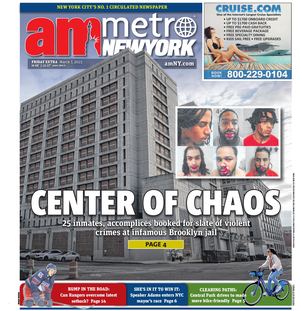The Brooklyn Navy Yard has hit a major milestone, surpassing 10,000 jobs for the first time since the city took control of the sprawling waterfront campus in 1966.
Amid its largest expansion since World War II — a $1 billion effort that resulted in the addition of 2.5 million square feet of space for businesses — the Brooklyn Navy Yard has gone from adding hundreds of new jobs a year to thousands, and development corporation president and CEO David Ehrenberg says they now expect to hit 20,000 jobs by 2021.
“We are trying to create a truly inclusive central business district,” Ehrenberg said. “So, it’s forward-looking and has growing and sustainable companies who are at the forefront of their industries, but also connects that economic activity back to the community within which it sits.”

The effort to foster a reciprocal relationship with the surrounding neighborhoods is deeply rooted in the Navy Yard’s history. Established in 1801, the Brooklyn Navy Yard served for decades as a thriving hub for middle class jobs. At its peak during World War II, the Brooklyn Navy Yard employed a whopping 70,000 workers.
“We were the lifeblood of Brooklyn’s middle class for generations,” Ehrenberg said. “Then, when the Navy Yard closed and all those jobs were lost, that was a huge blow to the borough.”
The city reopened the Navy Yard as an industrial park in 1969, but it languished through much the 1970s, ’80s and ’90s.
“It was in the 2000s, when the city started investing pretty significant amounts of money in the basic infrastructure that created the conditions that we have today where private companies can and want to establish themselves at the yard,” said Ehrenberg, reflecting on how far the Navy Yard has come. “It’s been a steady increase until a couple of years ago, and now we’re at the inflection point where you really start growing quickly.”
The current phase of development involves five projects that are expected to contribute to the Brooklyn Navy Yard’s projected 20,000 workforce, including the Green Manufacturing Center, home to the New Lab tech hub; a new 675,000-square-foot building at Dock 72 with WeWork as its anchor tenant; and the redeveloped 1 million-square-foot Building 77, which houses Catbird Jewelry, Armada NYC, Russ & Daughters and a variety of other businesses.
Steiner Studios, the country’s largest film and television production studio outside of Hollywood, is also in the midst of an expansion that will add 180,000 square feet of sound stages and 1,000 jobs.
The Admiral’s Row redevelopment is expected to generate 2,000 jobs through 78,000 square feet of retail space, 356,000 square feet of industrial space and 11,000 square feet of community space as well as the city’s first Wegmans Food Market. The popular supermarket chain announced in May it was looking to fill 350 part-time positions ahead of its opening on Oct. 27.

Ehrenberg said one of the BNYDC’s missions is to make sure many of those jobs go to Brooklyn residents. The BNYDC runs an on-site employment center to train and place local residents into jobs at the Navy Yard.
“Last year alone, we placed 550 people in jobs and the vast majority were local residents,” Ehrenberg said, adding that about two-thirds of the current workforce lives in Brooklyn. “This year, we opened a new high school at the Navy Yard to make sure students are getting trained in the kind of skills that our tenants are currently demanding and will demand in the future.”
The BNYDC also has a “master plan” for its next phase of development — a $2.5 billion investment expected to create an additional 10,000 jobs across three underused Navy Yard sites, bringing the total workforce to 30,000. The state is expected to have a hand in the next phase as well, promising funding for new pedestrian-friendly streetscapes along the Navy Yard corridor in an effort to better connect local workers to the site.
The Navy Yard’s proximity to the Brooklyn-Queens Expressway as well as the Manhattan and Brooklyn bridges has created a “tangle of unfriendly streets and corners” that employees have to navigate in order to get to work, said Ehrenberg, who welcomed the state’s investment.
“Connecting to communities is extraordinarily important, but if you can’t get there or you don’t feel safe getting there then that’s a problem,” Ehrenberg said. “[We’re] really trying to create an environment where industry can thrive but our local residents also see and know and feel that economic activity is happening with and for them.”


































